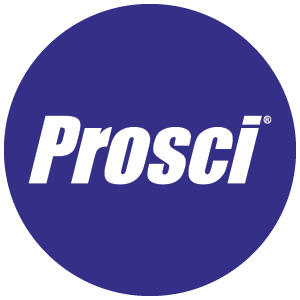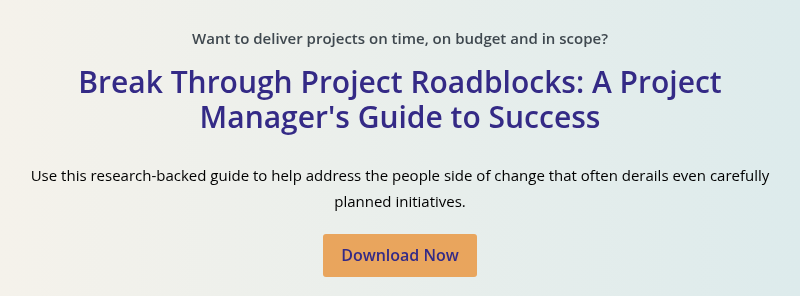Why Process Improvements Need Well-Managed Change

8 Mins
Updated: August 19, 2025
Published: December 1, 2024

No matter your industry or processes, there’s always room to elevate performance. But real growth doesn’t come from small tweaks—it comes from bold, strategic improvements that make a lasting impact.
Yet, rethinking entrenched processes can feel overwhelming. Process improvement methodologies provide a structured framework to help organizations identify and implement better ways of working. But even the best process improvement plan will fall short if it overlooks the people side of operational upheaval. That’s where change management comes in—helping your teams embrace and sustain new ways of working and achieve long-term success.
Read on to explore leading process improvement methods, best practices, and how integrating change management amplifies results.
What Are Process Improvements?
Process improvement is the strategic identification, analysis and optimization of business processes to drive better outcomes. By identifying bottlenecks, streamlining workflows and eliminating redundancies, organizations unlock greater efficiency, stronger performance and more resilient operations.
With the right methodology, teams can create lasting improvements that position the organization for agility and growth.

Why Business Process Improvements Matter
Process improvement isn’t about optimization for optimization’s sake—it’s about building an organization that runs smarter, faster and stronger. Here’s what’s possible:
- Increase efficiency – By identifying and eliminating inefficiencies, you can streamline workflows and optimize processes, achieving more with fewer resources.
- Reduce costs – Greater efficiency enables you to minimize waste and reallocate resources to high-value initiatives that drive growth.
- Boost productivity – Employees waste an average of 12.6 hours per week on low-value, repetitive tasks. By removing friction points and automating repetitive work, you empower your teams to focus on what truly moves the needle.
- Strengthen engagement – Disengagement and attrition can cost mid-sized companies up to $355 million per year in lost productivity. Empowering teams with better processes fosters ownership, reduces friction and boosts retention.
- Improve quality – Predictable, optimized processes lead to consistent, superior outcomes.
- Enhance agility – By optimizing processes, you make them more adaptable and scalable, enabling your organization to respond swiftly to growth and lead change.
The impact of process improvement depends on the methodology you choose and how well the new processes are adopted. Each approach brings a unique strategy for identifying, analyzing and optimizing workflows, but the real power lies in selecting the one that drives meaningful, lasting change. Here are some of the most common process improvement methodologies.
The Most Common Process Improvement Methodologies
There are a range of process improvement methodologies that help organizations unlock these benefits. You can adapt all of them to suit your industry or process improvement project.
Six Sigma
Six Sigma is a data-driven process improvement methodology designed to identify and eliminate process defects and inefficiencies.
This structured, customer-focused approach is both methodical and results-oriented, making it a go-to choice for organizations seeking precision and performance. It follows five key phases: Define, Measure, Analyze, Improve and Control (DMAIC).
Lean
The Lean methodology is a process improvement approach that focuses on reducing waste to make complex processes simpler and more valuable.
Because it was famously implemented and refined by Japanese carmaker Toyota, the Lean methodology is often referred to as the “Lean manufacturing” approach—but it can be applied to any sector or context.
Its primary goal is to help your organization create more value using fewer resources by identifying and correcting inefficiencies, reducing costs, and improving service quality.
Total Quality Management
The Total Quality Management (TQM) methodology is a comprehensive and structured approach to improving process quality.
The goal of TQM is to create an organizational culture of continuous improvement. It’s a process-centered approach that prioritizes collaboration.
TQM involves employees at every level within an organization to generate commitment from all the people impacted by the changes—building meaningful changes to process improvements from the ground up.
Kaizen
Kaizen is Japanese for “continuous improvement.” This methodology emphasizes incremental process improvement over time and recognizes that business process improvements aren’t a one-off occurrence. The improvement process is cyclical to ensure that changes to processes are sustainable and quality is maintained.
Kaizen is useful for organizations that want to better engage with front-line workers because it recognizes that they are best suited to identify inefficient processes.
Business process reengineering
Business process reengineering (BPR) is a systematic approach organizations use to redesign existing processes. It involves analyzing, designing, implementing, monitoring and continuously optimizing processes to achieve business objectives.
The goal is to make each of those processes more efficient, effective and adaptable to changing business environments. This allows organizations to reduce their costs, improve their outputs, and build quality levels.

Best Practices in Process Improvement
No two process improvement projects are 100% alike, but the right approach can turn any initiative into a success. By embedding these core practices into every effort, organizations can drive meaningful, sustainable improvements.
Establish clear objectives
No matter which process improvement methodology you choose, success starts with clear, well-defined goals. Establishing a clear purpose and measurable outcomes ensures your organization can track progress, measure impact, and refine strategies with confidence. Aligning improvements with business objectives ensures long-term optimization—not just short-term fixes.
Set SMART goals—specific, measurable, achievable, relevant and time-bound—to create a direct link between strategy and results. A structured, data-driven approach makes it easier to assess performance, course-correct when necessary.
Involve all stakeholders
Process improvements don’t happen in isolation—lasting change requires commitment from those impacted by the transformation. Engage employees at every level, along with key external stakeholders such as clients, customers and suppliers.
Establish structured forums or workshops to gather insights, analyze feedback, and uncover pain points in the process changes. When people feel heard and involved, they become champions of the change. Early engagement reduces resistance, accelerates adoption, and transforms process improvements into a shared commitment—not just a top-down directive.
Map current processes
To improve a process, you first need to understand it. Mapping out existing workflows in detail allows you to pinpoint inefficiencies, uncover bottlenecks, and identify opportunities for meaningful change.
Work with impacted teams to document how processes currently function. The right mapping tools—such as flow charts, value-stream maps, and SIPOC (suppliers, inputs, process, outputs, and customers) diagrams—help visualize inefficiencies and inform targeted improvements.
Document and standardize improvements
Process improvement isn’t a one-time event—it’s an ongoing commitment to doing things better. A continuous improvement mindset ensures change remains sustainable and adaptable.
Breaking changes into incremental sprints allows organizations to refine processes gradually, fostering collaboration and engagement at every stage. Small, measurable adjustments keep improvements on track while preventing change fatigue.
Equally important is recognizing contributions along the way. Acknowledging efforts maintains momentum, strengthens engagement, and reinforces a culture where improvement is expected.
Focus on continuous improvement
Continuous process improvement encourages incremental change that allows people time to adapt to new processes. Breaking down process changes into increments offers more opportunities to collaborate at all levels, creating sustainable commitment and ensuring all voices are heard.
The most effective approach is to implement incremental sprints, each focusing on a specific aspect of process improvement. This ensures change is steady, measurable and continuously refined.
It's also important to recognize contributions throughout the process. Acknowledging efforts reinforces engagement and helps prevent change fatigue in people as new improvements take shape.
 How to Effectively Introduce a Process Improvement System
How to Effectively Introduce a Process Improvement System
The initial phase of an improvement system or methodology is often poorly managed from a change perspective. Organizations and leaders can become so focused on the system itself that they forget to engage their employees. Sending out a single email announcing the adoption of Lean, for example, would likely leave front-line employees unaware of the reasons behind the changes affecting their daily work.
To effectively implement new business process improvements, you need to first manage the introduction of the system itself and then the project-related changes you're implementing.
Both phases require a structured process to build engagement and support. Essentially, both elements require effective change management. Failing to manage these transitions can lead to resistance, disengagement, and skepticism among employees about the new initiatives.
Integrating change management and project management from the start of the process helps change teams ensure alignment and adoption. The Unified Value Proposition is a Prosci framework that represents “change management on a page” and depicts how the people side and technical side of change work together toward a common goal of success.
Unified Value Proposition

By leveraging it alongside the full Prosci Methodology, you create a structured approach that supports individuals in successfully transitioning from the current state to the future state of the process.
The Prosci Methodology includes three primary components:

- Prosci Change Triangle (PCT) Model – This model highlights how proposed changes fit into the bigger picture to promote project health. It includes four aspects: Success, Leadership/Sponsorship, Project Management and Change Management.
- Prosci ADKAR® Model – This model focuses on individual change, guiding impacted individuals through change and addressing any roadblocks along the way.
- Prosci 3-Phase Process – This process supports organizational change by breaking the change journey down into three phases to achieve project outcomes: Phase 1 – Prepare Approach, Phase 2 – Manage Change, and Phase 3 – Sustain Outcomes.
When applied to process improvement, the Prosci Methodology transforms change from a challenge into an opportunity. By focusing on both organizational and individual adoption, it helps ensure improvements are embraced, implemented and sustained.
Applying Change Management to Increase Adoption of Process Improvements
Process improvement projects fuel progress and unlock new potential—but without a people-centered approach, even the best plans can stall.
This is where change management turns challenge into opportunity. By integrating change management with process improvement methodologies, you create a powerful, seamless strategy that drives adoption, reduces disruption, and enables lasting, high-impact results.
Here’s how you can embed change management into your process improvements to make change stick:
Understand the impact of change on employees
Business process improvements often require people to alter their workflows and adapt to new systems. Change management helps clarify the implications of these changes, ensuring that employees understand how their roles will evolve.
By integrating change management into your process improvement initiatives, you foster a better understanding of the changes among workers on the front line of your organization, leading to smoother transitions.
That’s what Velera did when they teamed up with Prosci to develop an organizational change management practice to support process improvements.
The team worked with impacted people at all levels to adopt a standard, proven change management methodology and deeper collaborative change management competencies. As a result, Velera successfully implemented and sustained its process improvements across its accounting system and timecard management.
Build a culture of engagement and support
Process improvements may face skepticism if employees feel excluded from decision-making. Change management emphasizes early and frequent engagement, fostering a sense of ownership over the changes.
By applying change management principles, you create an environment where employees feel valued and heard, strengthening their commitment.
That synergy can create positive culture shifts within your organization. By applying our ADKAR Model to structure and guide change management plans, you put the people side of change front and center throughout process improvements.
Provide training and resources for success
Process improvements require people to build new skills and adapt to new ways of working. Change management ensures they’re ready. By providing the right tools, training and support, you empower people to confidently step into their new roles.
Aligning training programs with process improvements is a strategic necessity. When you integrate learning into the change journey, employees are more likely to understand and embrace the new processes, accelerating adoption.
For example, you can create a training plan and include tailored training sessions that incorporate hands-on practice with new systems. This helps you ensures all the teams impacted have ample learning opportunities and receive guided support before, during and after each session so that they are confident in using new processes.
Reinforce change to sustain momentum
Process improvements need continuous reinforcement to ensure changes take hold and deliver lasting impact. A key element of change management is recognizing and celebrating successes to maintain momentum and reinforce commitment.
By integrating reinforcement strategies within process improvement initiatives, you can create a positive feedback loop that encourages continued adoption in your organization.
For example, you could hold regular recognition events to celebrate milestones achieved through process improvements. This would provide impacted people with a chance to look back on the progress made and reflect on the success of each improvement.
Address resistance proactively
Resistance to change can slow or even derail business process improvements. Change management offers a structured approach to uncover and address obstacles early, turning potential resistance into engagement and commitment.
By applying change management techniques to anticipate and mitigate resistance, your organization can minimize disruptions and enhance the likelihood of successful adoption.
For example, you could conduct readiness assessments to identify sources of dissatisfaction and develop targeted strategies to address them. This would allow you to proactively address potential sources of resistance before they materialize, supporting your employees through a smooth process improvement journey in which everyone is committed to the changes.
It’s Time to Change Process Improvement in Your Organization
Change is not an event—it’s a journey, especially when reshaping deeply embedded processes. Success demands a collaborative, iterative approach that drives both adoption and impact.
Embedding change management into process improvement is the key to turning new ways of working into competitive advantages. The Prosci Methodology provides a proven framework to accelerate adoption, minimize resistance, and create sustainable change.
Partner with Prosci to build world-class change management capabilities. With our expertise and resources, you’ll equip your organization to lead change with confidence.




